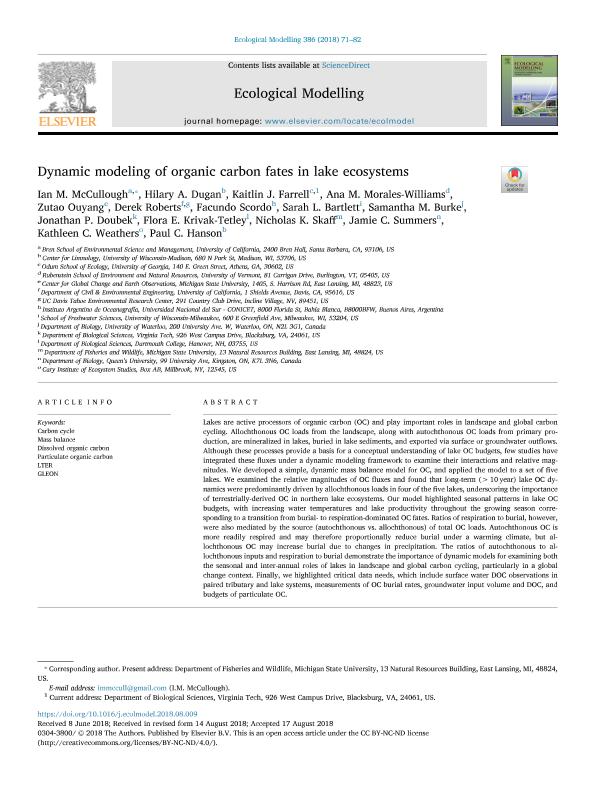Mostrar el registro sencillo del ítem
dc.contributor.author
McCullough, Ian M.
dc.contributor.author
Dugan, Hilary A.
dc.contributor.author
Farrell, Kaitlin J.
dc.contributor.author
Morales Williams, Ana M.
dc.contributor.author
Ouyang, Zutao
dc.contributor.author
Roberts, Derek
dc.contributor.author
Scordo, Facundo

dc.contributor.author
Bartlett, Sarah L.
dc.contributor.author
Burke, Samantha M.
dc.contributor.author
Doubek, Jonathan P.
dc.contributor.author
Krivak Tetley, Flora E.
dc.contributor.author
Skaff, Nicholas K.
dc.contributor.author
Summers, Jamie C.
dc.contributor.author
Weathers, Kathleen C.
dc.contributor.author
Hanson, Paul C.
dc.date.available
2019-10-18T15:52:33Z
dc.date.issued
2018-10-24
dc.identifier.citation
McCullough, Ian M.; Dugan, Hilary A.; Farrell, Kaitlin J.; Morales Williams, Ana M.; Ouyang, Zutao; et al.; Dynamic modeling of organic carbon fates in lake ecosystems; Elsevier Science; Ecological Modelling; 386; 24-10-2018; 71-82
dc.identifier.issn
0304-3800
dc.identifier.uri
http://hdl.handle.net/11336/86365
dc.description.abstract
Lakes are active processors of organic carbon (OC) and play important roles in landscape and global carbon cycling. Allochthonous OC loads from the landscape, along with autochthonous OC loads from primary production, are mineralized in lakes, buried in lake sediments, and exported via surface or groundwater outflows. Although these processes provide a basis for a conceptual understanding of lake OC budgets, few studies have integrated these fluxes under a dynamic modeling framework to examine their interactions and relative magnitudes. We developed a simple, dynamic mass balance model for OC, and applied the model to a set of five lakes. We examined the relative magnitudes of OC fluxes and found that long-term (>10 year) lake OC dynamics were predominantly driven by allochthonous loads in four of the five lakes, underscoring the importance of terrestrially-derived OC in northern lake ecosystems. Our model highlighted seasonal patterns in lake OC budgets, with increasing water temperatures and lake productivity throughout the growing season corresponding to a transition from burial- to respiration-dominated OC fates. Ratios of respiration to burial, however, were also mediated by the source (autochthonous vs. allochthonous) of total OC loads. Autochthonous OC is more readily respired and may therefore proportionally reduce burial under a warming climate, but allochthonous OC may increase burial due to changes in precipitation. The ratios of autochthonous to allochthonous inputs and respiration to burial demonstrate the importance of dynamic models for examining both the seasonal and inter-annual roles of lakes in landscape and global carbon cycling, particularly in a global change context. Finally, we highlighted critical data needs, which include surface water DOC observations in paired tributary and lake systems, measurements of OC burial rates, groundwater input volume and DOC, and budgets of particulate OC.
dc.format
application/pdf
dc.language.iso
eng
dc.publisher
Elsevier Science

dc.rights
info:eu-repo/semantics/openAccess
dc.rights.uri
https://creativecommons.org/licenses/by-nc-sa/2.5/ar/
dc.subject
Carbon Cycle
dc.subject
Dissolved Organic Carbon
dc.subject
GLEON
dc.subject
LTER
dc.subject
Mass Balance
dc.subject
Particulate Organic Carbon
dc.subject.classification
Oceanografía, Hidrología, Recursos Hídricos

dc.subject.classification
Ciencias de la Tierra y relacionadas con el Medio Ambiente

dc.subject.classification
CIENCIAS NATURALES Y EXACTAS

dc.title
Dynamic modeling of organic carbon fates in lake ecosystems
dc.type
info:eu-repo/semantics/article
dc.type
info:ar-repo/semantics/artículo
dc.type
info:eu-repo/semantics/publishedVersion
dc.date.updated
2019-08-08T19:32:29Z
dc.journal.volume
386
dc.journal.pagination
71-82
dc.journal.pais
Países Bajos

dc.journal.ciudad
Amsterdam
dc.description.fil
Fil: McCullough, Ian M.. University of California; Estados Unidos
dc.description.fil
Fil: Dugan, Hilary A.. University of Wisconsin-Madison; Estados Unidos
dc.description.fil
Fil: Farrell, Kaitlin J.. Dartmouth College; Estados Unidos. University of Georgia; Estados Unidos
dc.description.fil
Fil: Morales Williams, Ana M.. University of Vermont; Estados Unidos
dc.description.fil
Fil: Ouyang, Zutao. Michigan State University; Estados Unidos
dc.description.fil
Fil: Roberts, Derek. University of California at Davis; Estados Unidos. Tahoe Environmental Research Center; Estados Unidos
dc.description.fil
Fil: Scordo, Facundo. Consejo Nacional de Investigaciones Científicas y Técnicas. Centro Científico Tecnológico Conicet - Bahía Blanca. Instituto Argentino de Oceanografía. Universidad Nacional del Sur. Instituto Argentino de Oceanografía; Argentina
dc.description.fil
Fil: Bartlett, Sarah L.. University of Wisconsin-Milwaukee; Estados Unidos
dc.description.fil
Fil: Burke, Samantha M.. University of Waterloo; Canadá
dc.description.fil
Fil: Doubek, Jonathan P.. Virginia Tech University; Estados Unidos
dc.description.fil
Fil: Krivak Tetley, Flora E.. Dartmouth College; Estados Unidos
dc.description.fil
Fil: Skaff, Nicholas K.. Michigan State University; Estados Unidos
dc.description.fil
Fil: Summers, Jamie C.. Queen’s University; Canadá
dc.description.fil
Fil: Weathers, Kathleen C.. Cary Institute of Ecosystem Studies; Estados Unidos
dc.description.fil
Fil: Hanson, Paul C.. University of Wisconsin-Madison; Estados Unidos
dc.journal.title
Ecological Modelling

dc.relation.alternativeid
info:eu-repo/semantics/altIdentifier/url/https://linkinghub.elsevier.com/retrieve/pii/S0304380018302783
dc.relation.alternativeid
info:eu-repo/semantics/altIdentifier/doi/https://doi.org/10.1016/j.ecolmodel.2018.08.009
Archivos asociados
